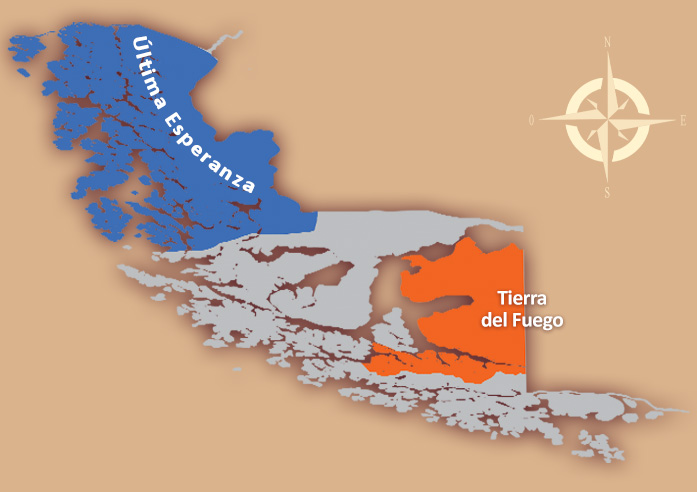KNOWING & CARING
KNOWING & CARING
Aves en Magallanes
The Magellan region, last great territory in the southernmost part of Patagonia, has a rugged orography that gives rise to mountain ranges, fjords, steppes and tundra. The climatic influence of the Atlantic and Pacific oceans determines life for plant and animal species that managed to adapt to these latitudes. This diversity of environments allows a variety of flora and fauna, which can be enjoyed in each of its parts.
Among the creatures in the region, birds stand out representing a surprising biodiversity often unknown.
There are 243 species of birds that inhabit the region (among residents, migratory, occasional and rare ones), adapting to its indomitable winds, its extreme temperatures. They are species capable of thriving either in the lush evergreen forests, in the areas of pampa or ice, as well as in the peat lands and on the southern coasts.
Patagonia is, without a doubt, a privileged territory for bird watching. In various parts of it, ecosystems are preserved, many of them unique worldwide, practically pristine.
Ducks, swans, geese, sandpipers, plovers and oystercatchers are the most abundant. Among the occasional ones, herons stand out; and among the rare: rails and divers.
The ecology of these birds is closely linked to the resources available in their environment. Many migratory species travel thousands of kilometers to take advantage of the favorable conditions of breeding and feeding, which the region offers during the southern summer. Seabirds, such as penguins and cormorants, find their livelihood in the abundant waters of the Atlantic Ocean, while birds of prey such as the black-chested buzzard eagle hunt in the vast steppes and forests.
La ecología de las aves patagónicas está estrechamente ligada a los recursos disponibles en su entorno. Muchas especies migratorias viajan miles de kilómetros para aprovechar las condiciones favorables de reproducción y alimentación que ofrece la región durante el verano austral. Las aves marinas, como los pingüinos y los cormoranes, encuentran su sustento en las ricas aguas del océano Atlántico, mientras que las rapaces como el águila mora cazan en las vastas estepas y bosques.
In Tierra del Fuego
The archipelago of Tierra del Fuego has, due to its location, very particular traits. Located just a thousand kilometers from Antarctica, its bird communities include species of continental Patagonian origin, as well as others of the coastal type.
Bahía LomasA place worthy of contemplation and care is Bahía Lomas. In 2024 it was declared a Ramsar site, which recognizes it as a wetland of international importance that must be preserved. In 2009 it was recognized as a Hemispheric Shorebird Reserve, since it is among the most important wetlands for this avian type in the southern hemisphere. It is, for example, the most important wintering area in South America for the Arctic sandpiper (Calidris canutus rufus), and the second in importance for the straight-billed curlew (Limosa haemastica).
Bahía InútilAlso, of singular importance is Bahía Inútil, an area where lives the only king penguin colony in South America. With an average height of 90 centimeters, it is the second largest penguin in the world, after the emperor penguin.
Further south, on Navarino Island and the southern tip of Tierra del Fuego, species such as albatrosses and petrels, cormorants and seagulls appear at different times of the year. Currently, this canal zone has been identified among the 24 wildest areas in the world, mainly due to the small human population and the vast terrestrial and marine areas barely impacted by human activity. The most abundant and diverse terrestrial vertebrates in the subantarctic region of Magellanic canals and fjords are birds, with 208 species in total.


Última Esperanza
In the province of Ultima Esperanza the iconic place is Torres del Paine National Park, whose natural richness was recognized by Unesco when granting it the status of biosphere reserve.
One of the main attractions of this protected wild area is the diversity of animal species, including 118 recognized birds. The majesty of the Andean condor (Vultur gryphus) stands out, but also the beauty of species such as the Darwin’s rhea (Rhea pennata), the Magellanic horned owl (Buho magellanicus) and the Austral pygmy owl (Glaucidium nana).
Recommendations
Bird watching is an activity that allows us make a connection nature and discover the natural heritage of a territory. But if not properly planned, it can pose risks to the observed species and to the environment; in addition of risking failing the goal of observing a bird in its natural, spontaneous and unaltered behavior. In 2017, after the First National Aviturism Meeting in Valdivia, a group of institutions developed a Code of Good Practice for Birdwatching in Chile.
• Do not touch eggs nor chicks.
• Attend sites in small groups of people.
• Avoid leaving trails or site viewers.
• Do not destroy or alter the vegetation.
• Avoid making call sounds.
• Avoid using bait.
• In case of observing any abnormal situation, report it to the authorities.
For more information:
cehum.org